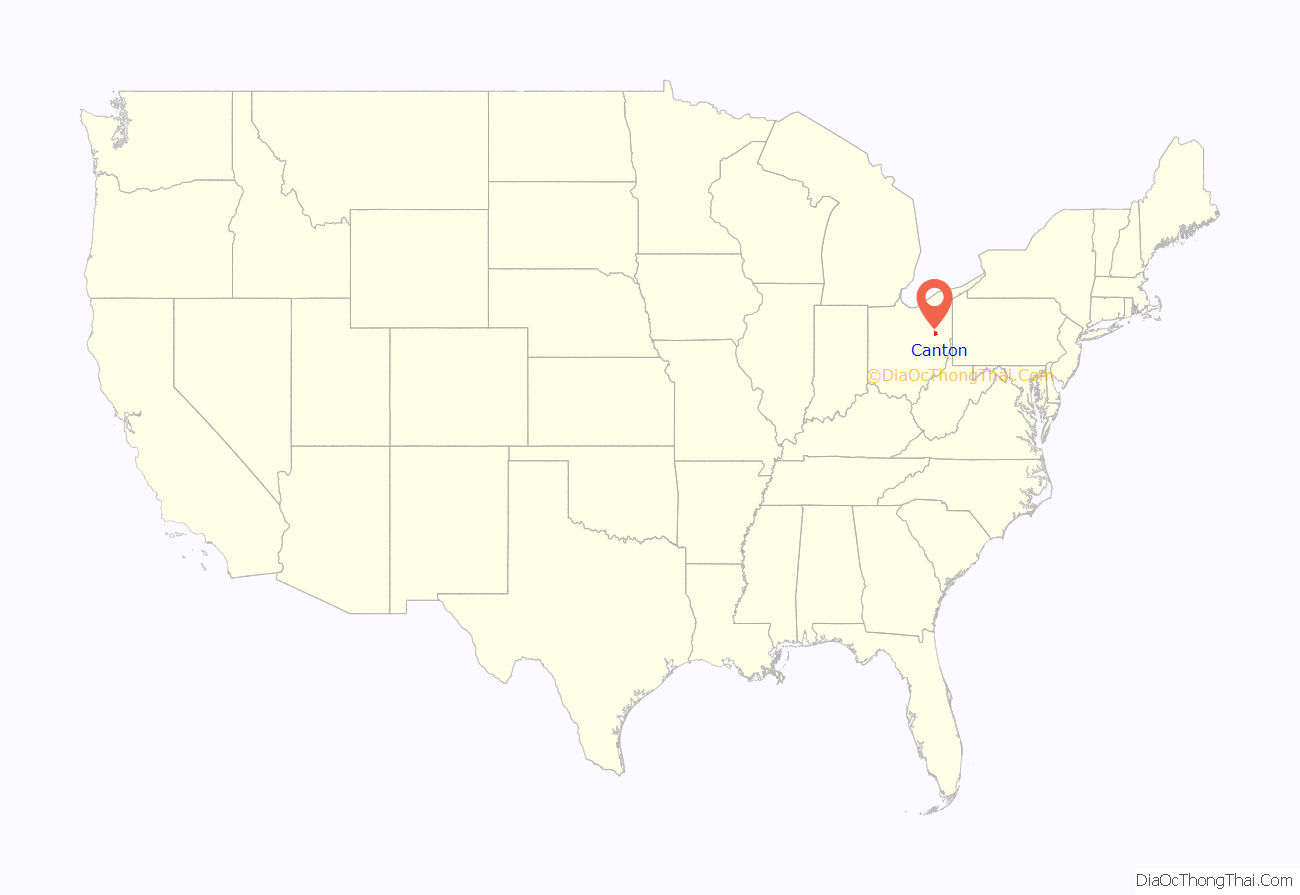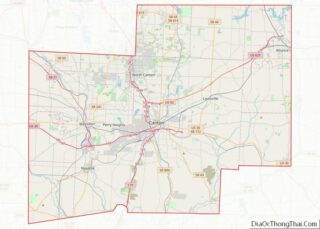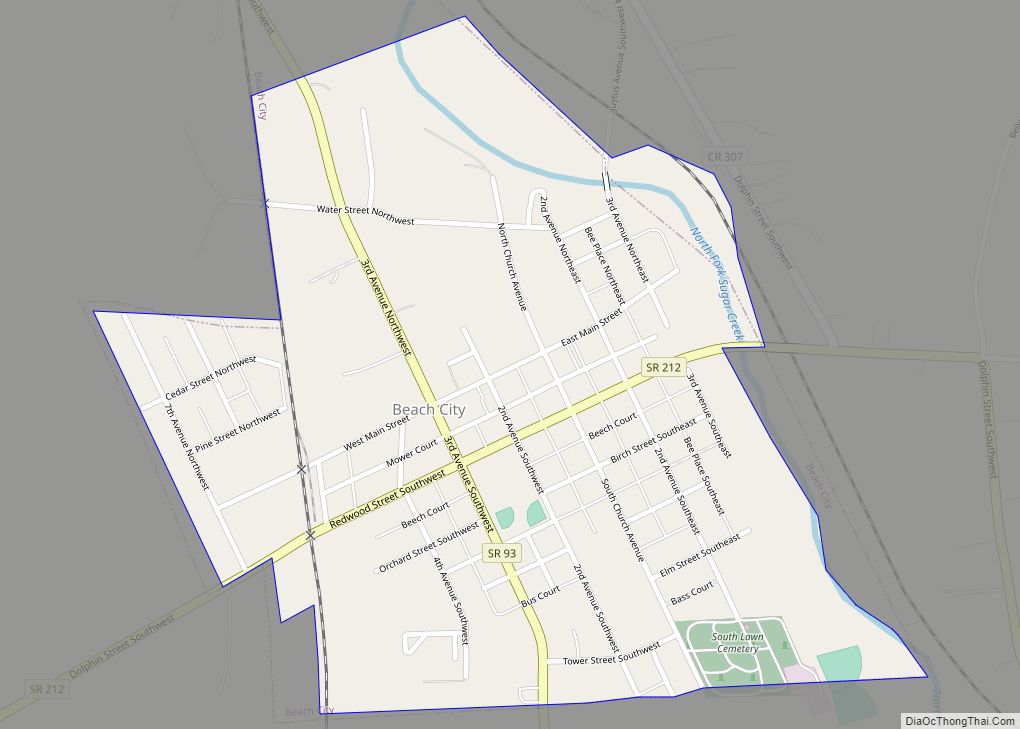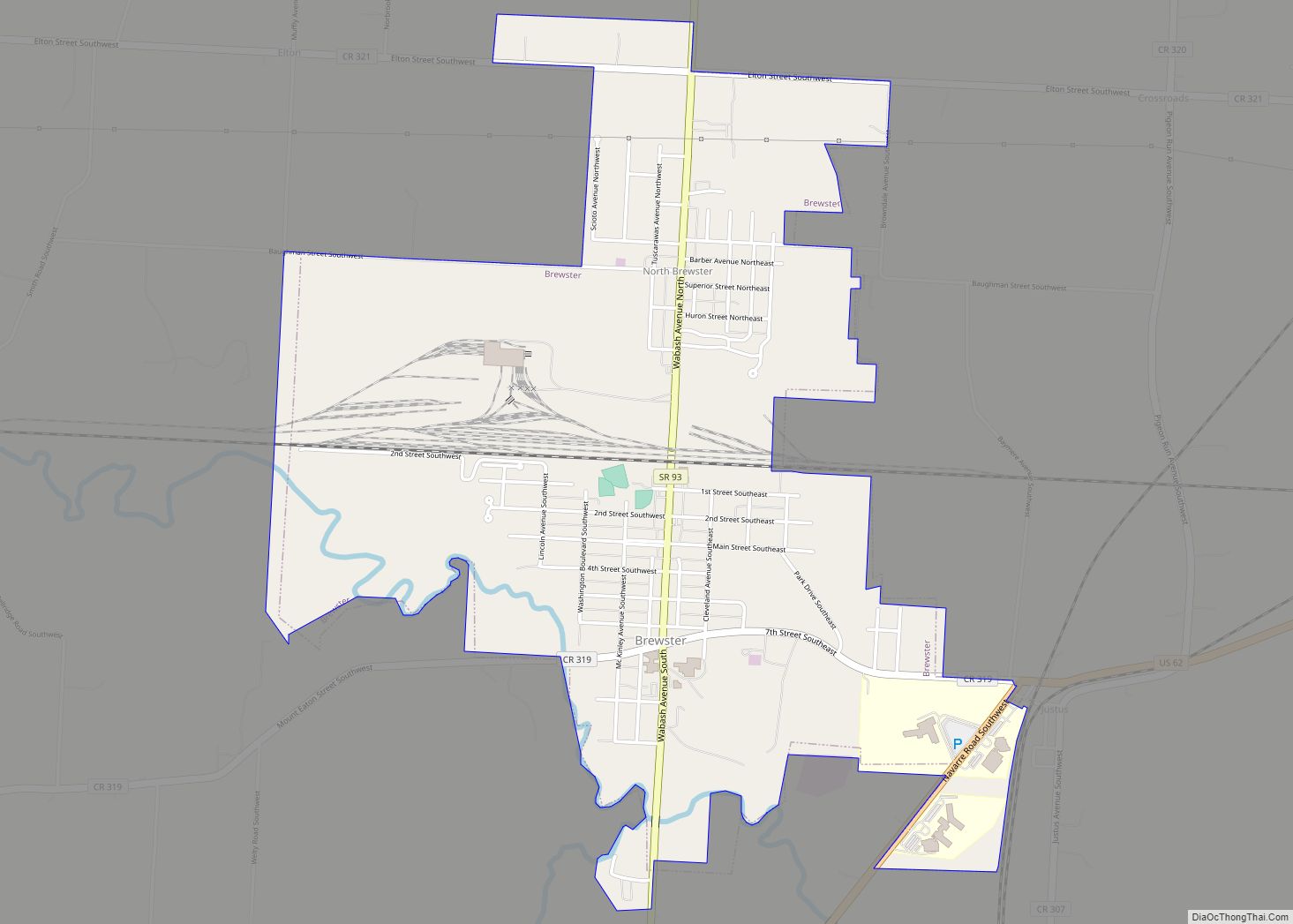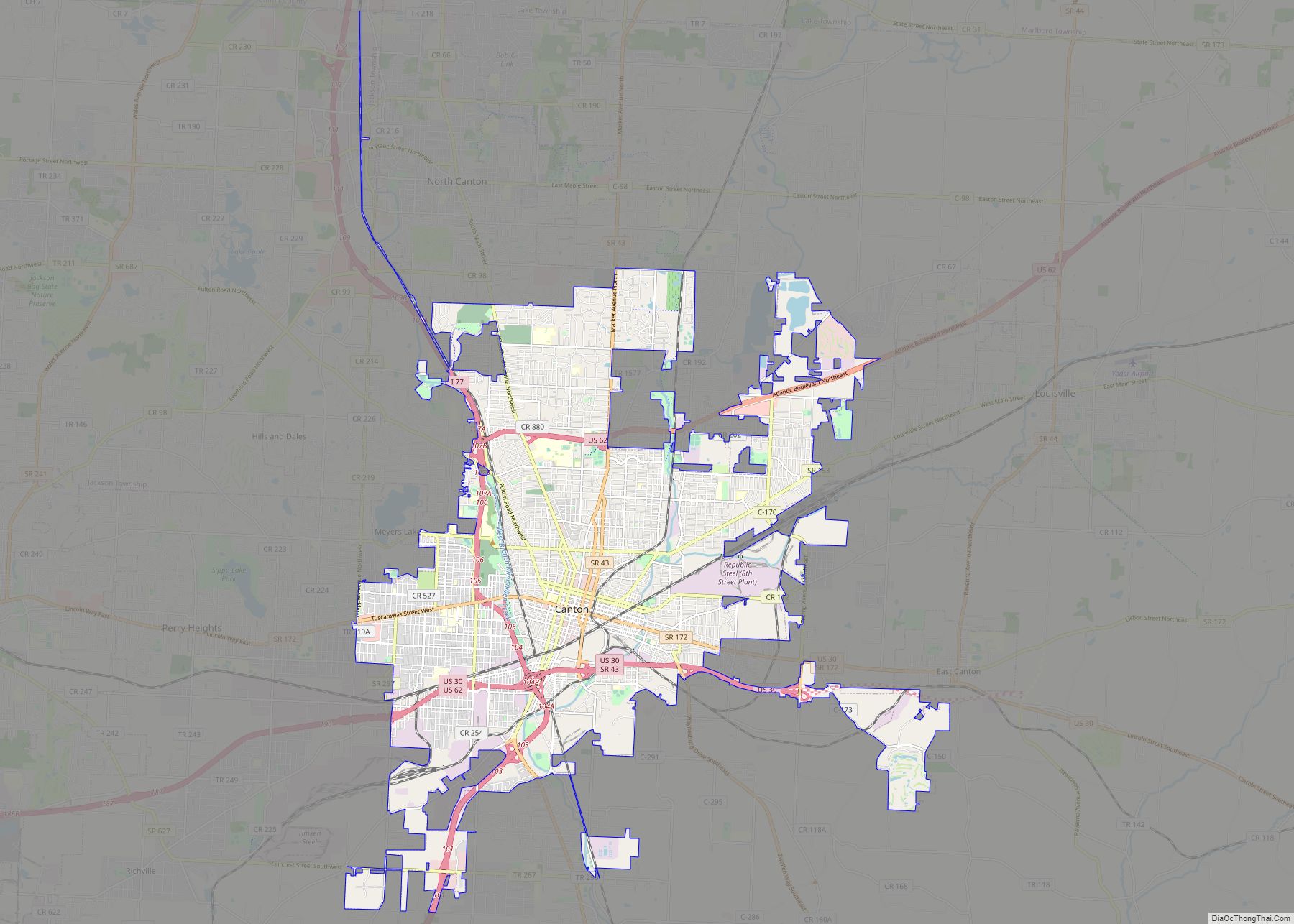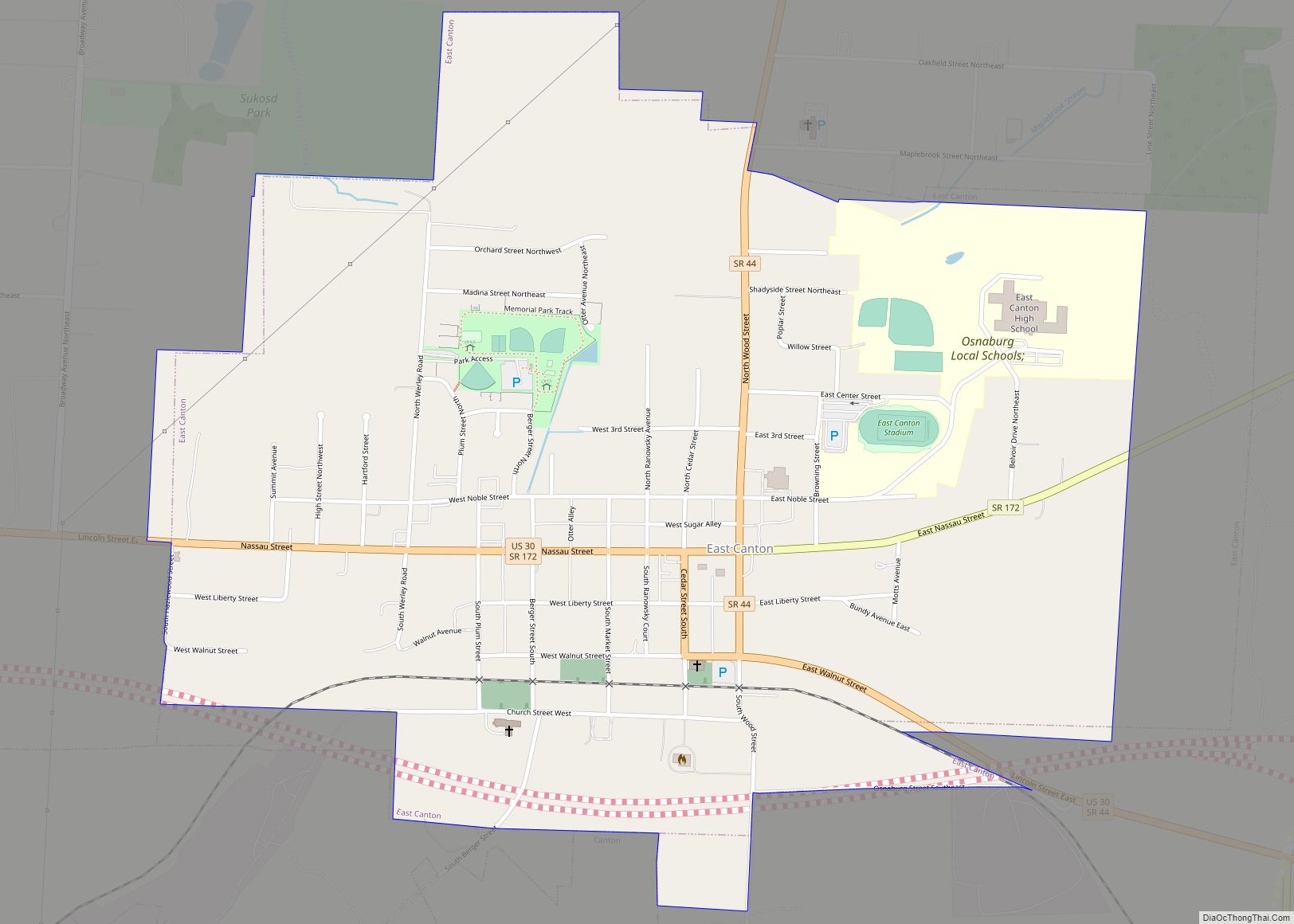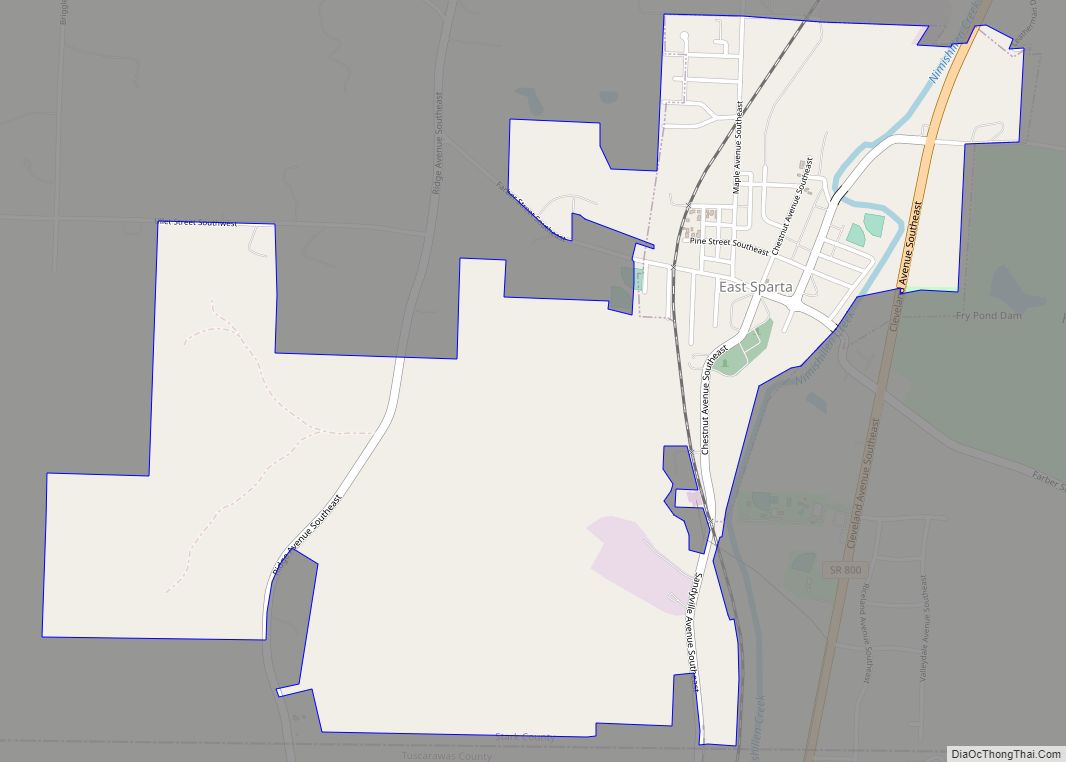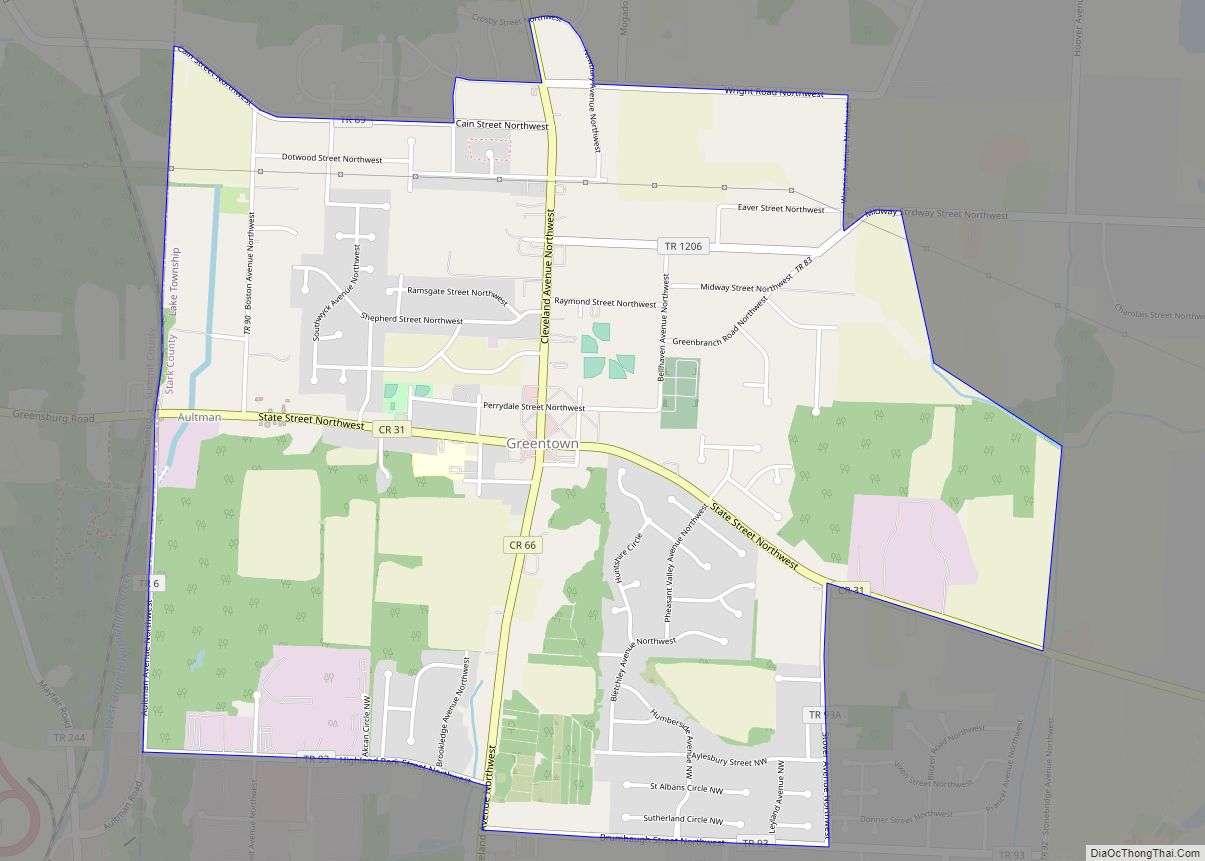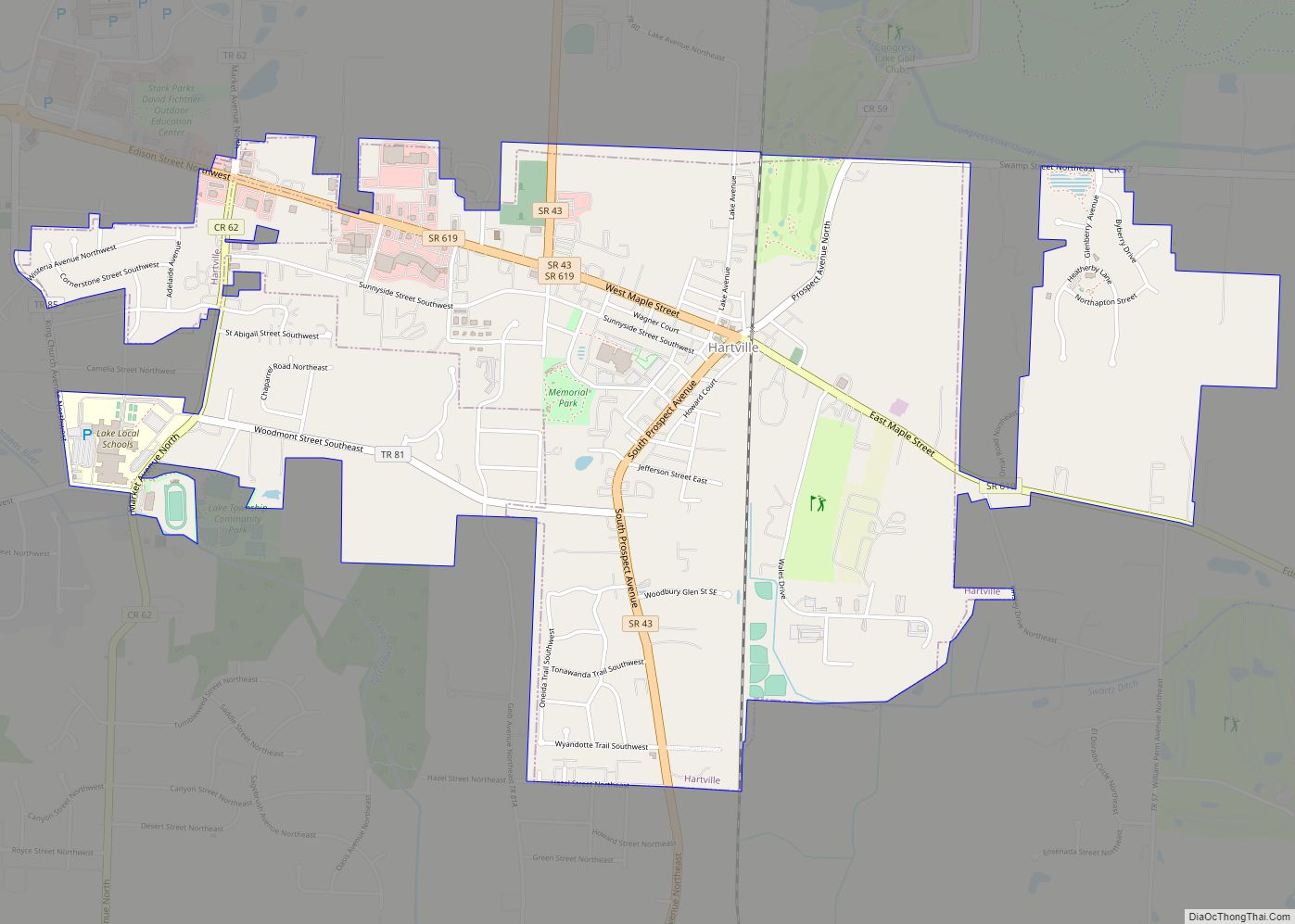Canton (/ˈkæntən/) is a city in and the county seat of Stark County, Ohio, United States. It is located approximately 60 miles (97 km) south of Cleveland and 20 miles (32 km) south of Akron in Northeast Ohio on the edge of Ohio’s Amish Country. As of the 2020 census, the population of Canton was 70,872, making Canton eighth among Ohio cities in population. It is the largest municipality in the Canton–Massillon metropolitan area, which includes all of Stark and Carroll counties, and was home to 401,574 residents in 2020.
Founded in 1805 alongside the Middle and West Branches of Nimishillen Creek, Canton became a heavy manufacturing center because of its numerous railroad lines. However, its status in that regard began to decline during the late 20th century, as shifts in the manufacturing industry led to the relocation or downsizing of many factories and workers. After this decline, the city’s industry diversified into the service economy, including retailing, education, finance and healthcare.
Canton is chiefly notable for being the home of the Pro Football Hall of Fame and the birthplace of the National Football League. 25th U.S. President William McKinley conducted the famed front porch campaign, which won him the presidency of the United States in the 1896 election, from his home in Canton. The McKinley National Memorial and the William McKinley Presidential Library and Museum commemorate his life and presidency. Canton was also chosen as the site of the First Ladies National Historic Site largely in honor of his wife, Ida Saxton McKinley.
Starting in the mid-2010s, Canton began experiencing an urban renaissance, anchored by a growing arts district centrally located in the downtown area. Several historic buildings have been rehabilitated and converted into upscale lofts, attracting hundreds of new downtown residents into the city. Furthering this downtown development, in June 2016, Canton became one of the first cities in Ohio to allow the open consumption of alcoholic beverages in a “designated outdoor refreshment area” pursuant to a state law enacted in 2015 (Sub. H.B. No. 47).
| Name: | Canton city |
|---|---|
| LSAD Code: | 25 |
| LSAD Description: | city (suffix) |
| State: | Ohio |
| County: | Stark County |
| Founded: | 1805 |
| Incorporated: | 1815 (village) |
| Elevation: | 1,060 ft (323 m) |
| Land Area: | 26.35 sq mi (68.25 km²) |
| Water Area: | 0.06 sq mi (0.16 km²) |
| Population Density: | 2,689.44/sq mi (1,038.41/km²) |
| FIPS code: | 3912000 |
| GNISfeature ID: | 1048580 |
| Website: | www.cantonohio.gov |
Online Interactive Map
Click on ![]() to view map in "full screen" mode.
to view map in "full screen" mode.
Canton location map. Where is Canton city?
History
Canton was founded in 1805, incorporated as a village in 1822, and re-incorporated as a city in 1838. The plat of Canton was recorded at New Lisbon, Ohio, on November 15, 1805, by Bezaleel Wells, a surveyor and devout Episcopalian from Maryland born January 28, 1763. Canton was likely named as a memorial to Captain John O’Donnell, an Irish merchant marine with the British East India Company whom Wells admired. O’Donnell named his estate in Maryland after the Chinese city Canton (a traditional English name for Guangzhou) as he had been the first person to transport goods from there to Baltimore. The name selected by Wells may also have been influenced by the Huguenot use of the word “canton,” which meant a division of a district containing several communes. Through Wells’ efforts and promotion, Canton was designated the county seat of Stark County upon its division from Columbiana County on January 1, 1809.
For most of his adult life, Canton was the home of William McKinley, the 25th president of the United States. Born in Niles, Ohio, McKinley first practiced law in Canton around 1867, and was prosecuting attorney of Stark County from 1869 to 1871. The city was his home during his successful campaign for Ohio governor, the site of his front-porch presidential campaign of 1896 and the campaign of 1900. Canton is now the site of the William McKinley Presidential Library and Museum and the McKinley National Memorial, dedicated in 1907.
Debs’ anti-war speech
On June 16, 1918, Eugene V. Debs delivered the keynote speech at the annual Ohio Socialist Convention held in Canton’s Nimisilla Park. At the time, Debs had been a four-time candidate for president and was considered the country’s leading socialist and labor organizer. During his speech he decried America’s involvement in the First World War, saying, “They have always taught you that it is your patriotic duty to go to war and slaughter yourselves at their command. You have never had a voice in the war. The working class who make the sacrifices, who shed the blood, have never yet had a voice in declaring war.” Among Debs’ audience at Nimisilla Park were agents of the U.S. Department of Justice. The year before his speech, and a month following the American entry into the First World War, President Woodrow Wilson signed the Espionage Act of 1917 into law. This Act made it a federal crime to interfere with, among other things, the Selective Service Act or military draft.
On June 30, 1918, Debs was arrested and charged with, among other things, “unlawfully, willfully and feloniously cause and attempt to cause and incite and attempt to incite, insubordination, disloyalty, mutiny and refusal of duty, in the military and naval forces of the United States.” Debs’ trial began on September 10, 1918, in the U.S. District Court for the Northern District of Ohio. On September 12, 1918, a jury found Debs guilty. He was sentenced to ten years in prison. On March 10, 1919, the U.S. Supreme Court affirmed the constitutionality of Debs’ conviction in Debs v. United States. Debs began serving his prison sentence on April 13, 1919. He remained incarcerated until September 25, 1921, when he was released after President Warren Harding commuted his sentence to time served.
The U.S. Supreme Court’s decision affirming Debs’ conviction was sharply criticized by legal scholars at the time and is generally regarded as a low-point in First Amendment jurisprudence. While Debs’ speech in Canton and subsequent conviction ultimately aided Debs in delivering the Socialist Party’s anti-war platform, his age and the deleterious effects of prison exhausted his ability as an orator. Debs died of heart failure on October 20, 1926. In June 2017 Canton applied for and received a historic marker from the Ohio History Connection, formerly the Ohio Historical Society, to commemorate Debs’ speech at Nimisilla Park and other historic events reflecting the park’s importance as a gathering place for the community.
Major companies
The Dueber-Hampden Watch Company was an important employer in Canton during the early 1920s. It formally organized in 1923, having previously consisted of two separate companies: the Dueber Watch Case Company and the Hampden Watch Company. In 1886, John Dueber, the owner of the Dueber Watch Case Company, purchased a controlling interest in the Hampden Watch Company. In 1888, he relocated the Hampden Watch Company from Springfield, Massachusetts and the Dueber Watch Case Company from Newport, Kentucky to Canton, Ohio. These two companies shared manufacturing facilities in Canton but remained two separate companies. The Dueber Watch Case Company and the Hampden Watch Company quickly became two of Canton’s largest employers. In 1888, the companies’ first year in Canton, they employed 2,300 Canton residents. In 1890, Canton’s population was 26,337. Thanks to these two companies, Canton became an important center for watch manufacturing in the United States. In 1927 the company went bankrupt, finally ceasing operations in the city in 1930. The machinery and tools were sold to the Amtorg Trading Corporation, one of Soviet Russia’s buying agencies in the US, for $329.000. The company’s massive brick factories, which covered more than 20 acres and included an ornate 150-foot clock tower, were demolished to accommodate the construction of Interstate 77.
The Timken Company has been among the largest employers in Canton for nearly 100 years. In 1898, Henry Timken obtained a patent for the tapered roller bearing, and in 1899 incorporated as the Timken Roller Bearing Axle Company in St. Louis. In 1901, the company moved to Canton as the automobile industry began to overtake the carriage industry. Timken and his two sons chose this location because of its proximity to the American car manufacturing centers of Detroit and Cleveland and the American steel-making centers of Pittsburgh and Cleveland. By 1960, Timken had operations in the U.S., Canada, Great Britain, France, South Africa, Australia and Brazil. The company changed its corporate structure in 2014; the roller bearing-producing part of the company was separated from the steel-producing part of the company, resulting in two separate companies. The Timken Company continues to manufacture roller bearings, while TimkenSteel produces steel.
Today, TimkenSteel remains headquartered in Canton and employs 2,800 people, most of them in Northeast Ohio. The company makes special bar quality steel, used in applications all over the world. The Timken Co. is now headquartered in Jackson Township, a suburb of Canton, and employs 14,000 people around the world. The company designs, engineers, manufactures and sells bearings, transmissions, gearboxes, chain and related products, and offers a spectrum of power system rebuild and repair services around the globe.
Football history
On September 17, 1920, a meeting was held at the Hupmobile showroom in the Independent Order of Odd Fellows Building in Canton to found the American Professional Football Association (renamed the National Football League in 1922). The attendees included Ralph Hay, owner of the Hupmobile showroom and the hometown Canton Bulldogs, and George Halas, owner of the Decatur Staleys. Jim Thorpe of the Bulldogs was the league’s first president. In 2014 a sculpture titled Birth of the NFL was erected in downtown Canton marking the exact location in the Hupmobile showroom where the NFL was created in 1920.
On December 6, 1959, the Canton Repository, a local newspaper, called for city officials to lobby the National Football League to create a football hall of fame in the community. Canton officials formally proposed their city as site for the hall of fame in 1961. The NFL quickly agreed to the city’s proposal. To help convince NFL officials to locate the hall of fame in Canton, city officials donated several acres of land on Canton’s north side to the project. Local residents also raised almost $400,000 to help construct the hall of fame.
The Pro Football Hall of Fame formally opened on September 7, 1963. Initially the museum consisted of two buildings, but in 1971, 1978, 1995, and 2013, the Pro Football Hall of Fame experienced several expansions. As of 2013, the museum consisted of five buildings, covering 118,000 square feet. Since its founding, over 10 million people have visited the Pro Football Hall of Fame. “Welcome to Canton” is the official way of saying congratulations to a new enshrinee.
Canton Road Map
Canton city Satellite Map
Geography
Topography
Canton is located at an elevation of 1,060 feet (323 m). Nimishillen Creek and its East, Middle and West Branches flow through the city.
Canton is bordered by Plain Township and North Canton to the north, Meyers Lake and Perry Township to the west, Canton Township to the South, and Nimishillen Township, Osnaburg Township and East Canton to the east. Annexations were approved in December 2006 extending Canton’s eastern boundary to East Canton‘s border.
According to the United States Census Bureau, the city has a total area of 25.48 square miles (65.99 km), of which 25.46 square miles (65.94 km) is land and 0.02 square miles (0.05 km) is water.
Climate
Canton has a humid continental climate (Köppen climate classification Dfa), typical of much of the Midwestern United States, with warm, humid summers and cold winters. Winters tend to be cold, with average January high temperatures of 34 °F (1 °C), and average lows of 19 °F (−7 °C), with considerable variation in temperatures. During a typical January, high temperatures of over 50 °F (10 °C) are just as common as low temperatures of below 0 °F (−18 °C). Snowfall is lighter than the snow belt areas to the north. Akron-Canton Airport generally averages 47.7 inches (121 cm) of snow per season. Springs are short with rapid transition from hard winter to summer weather. Summers tend to be warm, sometimes hot, with average July high temperatures of 83 °F (28 °C), and average July low of 62 °F (17 °C). Summer weather is more stable, generally humid with thunderstorms fairly common. Temperatures reach or exceed 90 °F (32 °C) about 10 times each summer, on average. Fall usually is the driest season with many clear, warm days and cool nights. The all-time record high in the Akron-Canton area of 104 °F (40 °C) was established on August 6, 1918, and the all-time record low of −25 °F (−32 °C) was set on January 19, 1994.
Address system
Canton’s street layout forms the basis for the system of addresses in Stark County. Canton proper is divided into address quadrants (NW, NE, SW, SE) by Tuscarawas Street (dividing N and S) and Market Avenue (dividing E and W). Due to shifts in the street layout, the E–W divider becomes Cleveland Avenue south of the city, merging onto Ridge Road farther out. The directionals are noted as suffixes to the street name (e.g. Tuscarawas St W, 55th Street NE). Typically within the city numbered streets run east and west and radiate from the Tuscarawas Street baseline, while named avenues run north and south.
This system extends into Stark County but is not shared by the cities of Massillon, Louisville, East Canton, Minerva or North Canton, which have their own internal address grids.
Neighborhoods
- Downtown
- Crystal Park
- Dueber
- Harter Heights
- Sherrick Road Corridor
- Market Heights
- Historic Ridgewood District
- Shorb
- Summit
- Vassar Park
- West Branch Park
- West Park
- Edgefield
- Lathrop
- Gibbs
- Colonial Heights
- Mt. Vernon
- Harrison Hills
- Plain Center Estates
- Westbrook Veterans Memorial Park
The Ridgewood Historic District is a historic residential neighborhood in Canton that, due to its architectural significance, was added to the U.S. National Register of Historic Places on December 19, 1982. The neighborhood consists of preserved, architect-designed Revival style buildings of the Tudor, Georgian, and French-Norman styles built in the early 20th century with amenities such as original brick streets and locally produced street lighting standards. The District features homes designed by several distinguished architects, including Charles Firestone, Herman Albrecht, and Louis Hoicowitz.
See also
Map of Ohio State and its subdivision:- Adams
- Allen
- Ashland
- Ashtabula
- Athens
- Auglaize
- Belmont
- Brown
- Butler
- Carroll
- Champaign
- Clark
- Clermont
- Clinton
- Columbiana
- Coshocton
- Crawford
- Cuyahoga
- Darke
- Defiance
- Delaware
- Erie
- Fairfield
- Fayette
- Franklin
- Fulton
- Gallia
- Geauga
- Greene
- Guernsey
- Hamilton
- Hancock
- Hardin
- Harrison
- Henry
- Highland
- Hocking
- Holmes
- Huron
- Jackson
- Jefferson
- Knox
- Lake
- Lake Erie
- Lawrence
- Licking
- Logan
- Lorain
- Lucas
- Madison
- Mahoning
- Marion
- Medina
- Meigs
- Mercer
- Miami
- Monroe
- Montgomery
- Morgan
- Morrow
- Muskingum
- Noble
- Ottawa
- Paulding
- Perry
- Pickaway
- Pike
- Portage
- Preble
- Putnam
- Richland
- Ross
- Sandusky
- Scioto
- Seneca
- Shelby
- Stark
- Summit
- Trumbull
- Tuscarawas
- Union
- Van Wert
- Vinton
- Warren
- Washington
- Wayne
- Williams
- Wood
- Wyandot
- Alabama
- Alaska
- Arizona
- Arkansas
- California
- Colorado
- Connecticut
- Delaware
- District of Columbia
- Florida
- Georgia
- Hawaii
- Idaho
- Illinois
- Indiana
- Iowa
- Kansas
- Kentucky
- Louisiana
- Maine
- Maryland
- Massachusetts
- Michigan
- Minnesota
- Mississippi
- Missouri
- Montana
- Nebraska
- Nevada
- New Hampshire
- New Jersey
- New Mexico
- New York
- North Carolina
- North Dakota
- Ohio
- Oklahoma
- Oregon
- Pennsylvania
- Rhode Island
- South Carolina
- South Dakota
- Tennessee
- Texas
- Utah
- Vermont
- Virginia
- Washington
- West Virginia
- Wisconsin
- Wyoming
